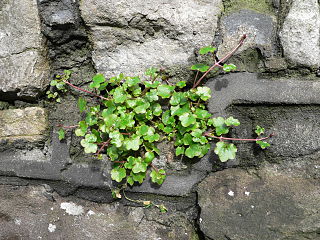
Cymbalaria muralis, with common names ivy-leaved toadflax, Kenilworth ivy, coliseum ivy, Oxford ivy, mother of thousands, pennywort, wandering sailor, is a flowering plant in the family Plantaginaceae native to Mediterranean Europe and widely naturalised elsewhere.

Lithophragma is a genus of flowering plants containing about nine species native to western North America. These plants are known generally as woodland stars. The petals of the flowers are usually bright white with deep, long lobes or teeth. Each petal may look like three to five petals, when at closer inspection the lobes fuse into a single petal at its base. Most species reproduce via bulblets instead of seeds. L. maximum is a federally listed endangered species. Lithophragma specifically coevolved with moths of the genus Greya, who pollinate and only lay eggs on Lithophragma plants.

Verbascum blattaria, the moth mullein, is a flowering biennial plant belonging to the figwort family Scrophulariaceae. A native of Eurasia and North Africa, it has naturalized in the United States and most of Canada since its introduction and has become an invasive species there. It has been declared a noxious weed by the state of Colorado.

Eriogonum luteolum is a species of wild buckwheat known by the common name goldencarpet buckwheat. It is native to many of the mountain ranges of California and southern Oregon, including the Sierra Nevada, Cascades and California Coast Ranges. It grows in mountain and foothill habitat, such as forest and woodland, on granite and sometimes serpentine soils.

Lithophragma affine is a species of flowering plant in the saxifrage family known by the common name San Francisco woodland star. It is native to the coast of western North America from Oregon to Baja California, where it grows in open habitat on mountain slopes, hills, and canyonsides. It is a rhizomatous perennial herb growing erect or leaning with a tall naked flowering stem. The leaves are located on the lower part of the stem, each divided into sharp-pointed lobes. The stem bears up to 15 widely spaced flowers, each in a cuplike calyx of red or green sepals. The five petals are bright white, up to 1.3 centimeters long, and divided into three toothlike lobes at the tips.
Lithophragma bolanderi is a species of flowering plant in the saxifrage family known by the common name Bolander's woodland star. It is endemic to California, where it is known from several mountain ranges, including the North Coast Ranges, the foothills of the Sierra Nevada, and the San Gabriel Mountains. It grows in many types of open habitat. It is a rhizomatous perennial herb growing erect or leaning with a tall naked flowering stem. The leaves are located on the lower part of the stem, each divided into rounded lobes. The stem bears up to 25 flowers, each in a cuplike calyx of red or green sepals. The five petals are white, under one centimeter long, and toothed or smooth along the edges.
Lithophragma campanulatum is a species of flowering plant in the saxifrage family known by the common name Siskiyou Mountain woodland star. It is native to southern Oregon and northern California, where it grows in the forests and woods of the mountains. It is a rhizomatous perennial herb growing erect or leaning with a tall naked flowering stem. The leaves are mostly located on the lower part of the stem, each divided into rounded lobes, sometimes narrowed into teeth. The stem bears 2 to 11 flowers, each in a cuplike calyx of red or green sepals. The five petals are white, under one centimeter long, and divided into irregular toothlike lobes.
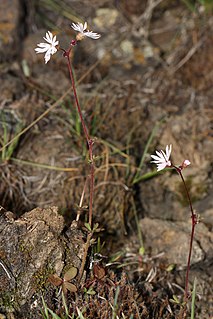
Lithophragma glabrum is a slender perennial western North American mountain plant in the Saxifrage family (Saxifragaceae), known by the common names bulbous woodland star, bulbiferous prairie-star, smooth woodland star, and smooth rockstar.

Lithophragma heterophyllum, commonly known as hillside woodland star, is a species of flowering plant in the saxifrage family found in the western United States. It is native to the coastal mountain ranges of California, where it can generally be found in shady habitat. It is a rhizomatous perennial herb growing erect or leaning with a slender naked flowering stem. The leaves are located on the lower part of the stem, each divided into rounded lobes. The stem bears 3 to 12 flowers, each in a cuplike calyx of red or green sepals. The five petals are white, up to 1.2 centimeters long, and usually divided into about three pointed lobes.
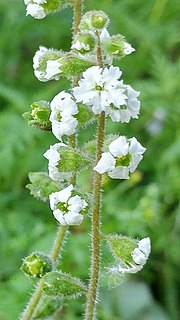
Lithophragma maximum, known by the common name San Clemente Island woodland star, is a rare species of flowering plant in the saxifrage family. It is endemic to San Clemente Island, one of the eight Channel Islands of California. It is known from only about four kilometers of rocky coastal cliffs on the edge of the island. The plant was thought to be extinct until a few specimens were rediscovered in 1979. Only 200 individuals were tallied in a 1996 survey. In 1997 the plant was listed as an endangered species on the federal level.

Lithophragma parviflorum is a species of flowering plant in the saxifrage family known by the common name smallflower woodland star. It is native to much of western North America from British Columbia to California to South Dakota and Nebraska, where it grows in several types of open habitat. It is a rhizomatous perennial herb growing erect or leaning with a naked flowering stem. The leaves are mainly located low on the stem, each cut into three lobes or divided into three lobed leaflets. The stem bears up to 14 flowers, each in a cuplike calyx of red or green sepals. The five petals are bright white, up to 1.6 centimeters long, and usually divided into three toothlike lobes.

Lithophragma tenellum is a species of flowering plant in the saxifrage family known by the common name slender woodland star.
Muilla transmontana is a species of flowering plant known by the common name Inland muilla. It is native to sections of the Great Basin in Nevada and in California east of the major mountain ranges. It grows in mountain forest and scrubby high desert and plateau habitat.
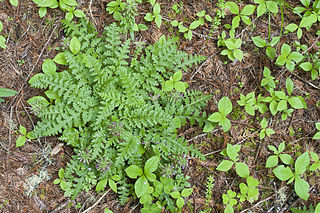
Pedicularis dudleyi is a rare species of flowering plant in the family Orobanchaceae known by the common name Dudley's lousewort. It is endemic to central California, where it is known from about ten scattered occurrences along the coast and in the coastal mountain ranges. It has been found in three locations along the Central California coast. The species was named for 19th-century Stanford University botanist William Dudley.
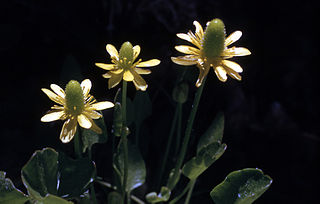
Ranunculus cymbalaria is a species of buttercup known by the common names alkali buttercup and seaside buttercup. It is native to much of Eurasia and parts of North and South America, where it grows in many types of habitat, especially in moist to wet areas such as marshes, bogs, and moist spring meadows. It is a perennial herb producing several stems a few centimeters to nearly 40 centimeters long. Some are prostrate against the ground and are stolons which root in moist substrate, and some are erect. The leaves are variable in shape, the basal ones with notched or slightly divided leaf blades borne on long petioles, and any upper leaves much reduced in size. The inflorescence bears one or more flowers on erect stalks. The flower has five to eight pale yellow petals, each under a centimeter long. The protruding receptacle at the center of the flower becomes a cylindrical cluster of fruits, each of which is an achene.

Sibara filifolia, the Santa Cruz Island winged rockcress or Santa Cruz Island rockcress, is a rare species of flowering plant in the family Brassicaceae. It is endemic to the Channel Islands of California, where it is now known from a few occurrences on San Clemente Island and one population on Catalina Island.
Frasera neglecta is a species of flowering plant in the gentian family known by the common name pine green gentian.
Astragalus sinuatus is a species of flowering plant in the legume family known by the common name Whited's milkvetch. It is endemic to Washington in the United States, where it is limited to one creek drainage on the western edge of the Columbia Basin. Its range measures about ten square miles in Chelan and Kittitas Counties in the central part of the state.
Lithophragma trifoliatum is a variety of flowering plant in the saxifrage family known from the western slope of the Cascade Range and Sierra Nevada in California. It is sometimes considered its own species based on the pink, fragrant flowers, the shape of the hypanthium, and other characters. Others consider it to be a sterile variety of L. parviflorum that likely now persists by vegetative reproduction.

Cymbalaria pallida is a flowering plant belonging to the family Plantaginaceae.














